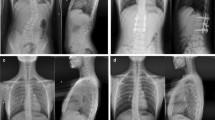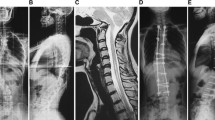Abstract
Study design
Retrospective case series.
Objective
To study the correction and fusion strategies for adult thoracolumbar or lumbar scoliosis with Chiari malformation and syringomyelia by using posterior pedicle screw instrumentation (PPSI).
Summary of background data
Surgical intervention for Chiari malformation and syringomyelia before surgical correction of scoliosis has been reported; however, there are no clinical trials for the PPSI-based correction and fusion procedures used in these patients.
Methods
From 2002 to 2009, 13 adult patients (mean age, 34.9 years) suffering from thoracolumbar or lumbar scoliosis with Chiari malformation and syringomyelia underwent correction and fusion by using PPSI. Preoperative, postoperative, and final follow-up coronary Cobb angle, correction rate, pelvic obliquity (PO), apical vertebral rotation (AVR), apical vertebral translation (AVT), trunk shift (TS), sagittal thoracic kyphosis angle, and lumbar lordosis angle were analyzed on radiographs.
Results
The preoperative and postoperative mean coronary Cobb angle was from 46.8° to 9.2°, correction rate was 80.7%, PO from 9.9° to 3.2°, AVR from 1.9° to 0.3°, AVT from 3.6 to 0.8 cm, TS from 16.8 to 1.6 cm, sagittal thoracic kyphosis angle from 18.2° to 23.5°, and lumbar lordosis angle was from 37.4° to 41.8°. The mean follow-up period was 35.2 months (range, 24–50 months). There were no obvious pseudoarticulations or loss of correction and trunk equilibrium at the final follow-up; no aggravation of the original neural symptoms or new irreversible neural injury was observed.
Conclusions
In patients with mild or moderate adult thoracolumbar or lumbar scoliosis with Chiari malformation and syringomyelia, the correction and fusion by using PPSI can yield a satisfactory clinical effect.

Similar content being viewed by others
References
Shufflebarger HL, Geck MJ, Clark CE (2004) The posterior approach for lumbar and thoracolumbar adolescent idiopathic scoliosis: posterior shortening and pedicle screws. Spine 29:269–276
Zhang HQ, Chen LQ, Guo CF et al (2008) Should syrinx be treated in patients with scoliosis complicated by syringomyelia without neurologic symptom? Orthop J China 16:961–965
Qiu Y, Wang B, Zhu ZZ et al (2003) Clinical manifestation and treatment strategy of scoliosis associated with Chiari malformation and/or syringomyelia. Chin J Orthop 23:564–567
Bradley LJ, Ratahi ED, Crawford HA et al (2007) The outcomes of scoliosis surgery in patients with syringomyelia. Spine 32:2327–2333
Modi HN, Suh SW, Song HR et al (2008) Treatment of neuromuscular scoliosis with posterior-only pedicle screw fixation. J Orthop Surg Res 3:23
Modi HN, Suh SW, Song HR et al (2008) Correction of apical axial rotation with pedicular screws in neuromuscular scoliosis. J Spinal Disord Tech 21:606–613
Wang Y, Fei Q, Qiu G et al (2008) Anterior spinal fusion versus posterior spinal fusion for moderate lumbar/thoracolumbar adolescent idiopathic scoliosis. Spine 33:2166–2172
Pateder DB, Kebaish KM, Cascio BM et al (2007) Posterior only versus combined anterior and posterior approaches to lumbar scoliosis in adults. Spine 32:1551–1554
Zhang HQ, Lu SJ, Chen J et al (2007) Treatment of severe idiopathic scoliosis with wide posterior spinal release and 3D spinal correction. Chin J Spine Spinal Cord 17:274–279
Kim YJ, Lenke LG, Bridwell KH et al (2007) Proximal junctional kyphosis in adolescent idiopathic scoliosis after 3 different types of posterior segmental spinal instrumentation and fusion: incidence and risk factor analysis of 410 cases. Spine 32:2731–2738
Li M, Gu SX, Zhu XD et al (2007) Use of posterior pedicle instrumentation on lumbar and thoracolumbar adolescent idiopathic scoliosis. Chin J Spine Spinal Cord 17:261–265
Huang DS, Yin HD, Su PQ et al (2008) Effect of different type of pedicle screws placement in concavity side of apical vertebrae on the treatment of adolescent idiopathic scoliosis. Chin J Spine Spinal Cord l8:172–176
Eule JM, Erickson MA, OBrien MF et al (2002) Chiari I malformation associated with syringomyelia and scoliosis: a twenty-year review of surgical and nonsurgical treatment in a pediatric population. Spine 27:145l–1455
Gitelman A, Joseph SA Jr, Carrion W et al (2008) Results and morbidity in a consecutive series of patients undergoing spinal fusion with iliac screws for neuromuscular scoliosis. Orthopedics 31:1198
Shufflebarger H, Suk SI, Mardjetko S (2006) Debate: determining the upper instrumented vertebra in the management of adult degenerative scoliosis: stopping at T10 versus L1. Spine 31:S185–S194
Kuklo TR (2006) Principles for selecting fusion levels in adult spinal deformity with particular attention to lumbar curves and double major curves. Spine 31:S132–S138
McCarthy RE (1999) Management of neuromuscular scoliosis. Orthop Clin North Am 30:435–449
Whitaker C, Burton DC, Asher M (2000) Treatment of selected neuromuscular patients with posterior instrumentation and arthrodesis ending with lumbar pedicle screw anchorage. Spine 25:2312–2318
Kim YJ, Bridwell KH, Lenke LG et al (2006) Pseudarthrosis in long adult spinal deformity instrumentation and fusion to the sacrum: prevalence and risk factor analysis of 144 cases. Spine 31:2329–2336
Acknowledgments
The authors thank Shi-Jin Lu, MD, Yu-Xiang Wang, MD, Ren-Mei Xiong, MD, working in Xiangya Hospital of Central South University for the skillful technical help they rendered. The Ethics Committee in Xiangya Hospital of Central South University approved the study. The study was not supported by any grant. The authors have no conflicts of interest to declare.
Author information
Authors and Affiliations
Corresponding author
Rights and permissions
About this article
Cite this article
Zhang, HQ., Deng, A., Liu, SH. et al. Adult thoracolumbar or lumbar scoliosis with Chiari malformation and syringomyelia: a retrospective study of correction and fusion strategies. Arch Orthop Trauma Surg 131, 475–480 (2011). https://doi.org/10.1007/s00402-010-1151-y
Received:
Published:
Issue Date:
DOI: https://doi.org/10.1007/s00402-010-1151-y




